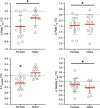Sex differences in adaptation to intermittent post-exercise sauna bathing in trained middle-distance runners
- PMID: 34297227
- PMCID: PMC8302716
- DOI: 10.1186/s40798-021-00342-6
Sex differences in adaptation to intermittent post-exercise sauna bathing in trained middle-distance runners
Abstract
Background: The purpose of this study was to investigate the effect of sex on the efficacy of intermittent post-exercise sauna bathing to induce heat acclimation and improve markers of temperate exercise performance in trained athletes.
Methods: Twenty-six trained runners (16 female; mean ± SD, age 19 ± 1 years, V̇O2max F: 52.6 ± 6.9 mL⋅kg-1⋅min-1, M: 64.6 ± 2.4 mL⋅kg-1⋅min-1) performed a running heat tolerance test (30 min, 9 km⋅h-1/2% gradient, 40 °C/40%RH; HTT) and temperate (18 °C) exercise tests (maximal aerobic capacity [V̇O2max] and lactate profile) pre and post 3 weeks of normal exercise training plus 29 ± 1 min post-exercise sauna bathing (101-108 °C) 3 ± 1 times per week.
Results: Females and males exhibited similar reductions (interactions p > 0.05) in peak rectal temperature (- 0.3 °C; p < 0.001), skin temperature (- 0.9 °C; p < 0.001) and heart rate (- 9 beats·min-1; p = 0.001) during the HTT at post- vs pre-intervention. Only females exhibited an increase in active sweat glands on the forearm (measured via modified iodine technique; F: + 57%, p < 0.001; M: + 1%, p = 0.47). Conversely, only males increased forearm blood flow (measured via venous occlusion plethysmography; F: + 31%, p = 0.61; M: + 123%; p < 0.001). Females and males showed similar (interactions p > 0.05) improvements in V̇O2max (+ 5%; p = 0.02) and running speed at 4 mmol·L-1 blood lactate concentration (+ 0.4 km·h-1; p = 0.001).
Conclusions: Three weeks of post-exercise sauna bathing effectively induces heat acclimation in females and males, though possibly amid different thermoeffector adaptations. Post-exercise sauna bathing is also an effective ergogenic aid for both sexes.
© 2021. The Author(s).
Conflict of interest statement
The authors, Nathalie V. Kirby, Samuel J. E. Lucas, Thomas G. Cable, Oliver J. Armstrong, Samuel R. Weaver, and Rebekah A. I. Lucas, declare that they have no competing interests.
Figures




References
-
- World Athletics . Beat the heat during the IAAF World Athletics Championships Doha 2019 and the Tokyo 2020 Olympics. 2019. pp. 1–12.
LinkOut - more resources
Full Text Sources
Miscellaneous

